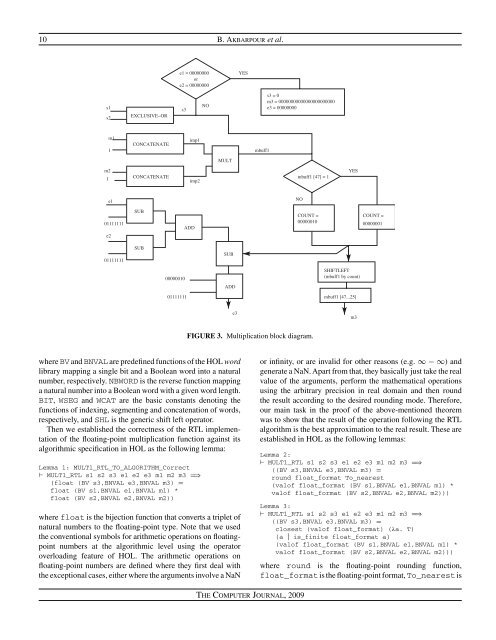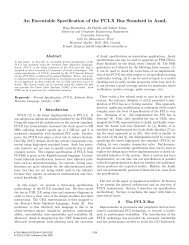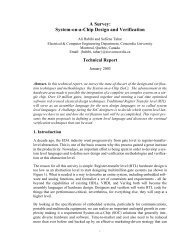Verifying a Synthesized Implementation of IEEE-754 Floating-Point ...
Verifying a Synthesized Implementation of IEEE-754 Floating-Point ...
Verifying a Synthesized Implementation of IEEE-754 Floating-Point ...
- No tags were found...
You also want an ePaper? Increase the reach of your titles
YUMPU automatically turns print PDFs into web optimized ePapers that Google loves.
10 B. Akbarpour et al.FIGURE 3. Multiplication block diagram.where BV and BNVAL are predefined functions <strong>of</strong> the HOL wordlibrary mapping a single bit and a Boolean word into a naturalnumber, respectively. NBWORD is the reverse function mappinga natural number into a Boolean word with a given word length.BIT, WSEG and WCAT are the basic constants denoting thefunctions <strong>of</strong> indexing, segmenting and concatenation <strong>of</strong> words,respectively, and SHL is the generic shift left operator.Then we established the correctness <strong>of</strong> the RTL implementation<strong>of</strong> the floating-point multiplication function against itsalgorithmic specification in HOL as the following lemma:Lemma 1: MULT1_RTL_TO_ALGORITHM_Correct⊢ MULT1_RTL s1 s2 s3 e1 e2 e3 m1 m2 m3 =⇒(float (BV s3,BNVAL e3,BNVAL m3) =float (BV s1,BNVAL e1,BNVAL m1) *float (BV s2,BNVAL e2,BNVAL m2))where float is the bijection function that converts a triplet <strong>of</strong>natural numbers to the floating-point type. Note that we usedthe conventional symbols for arithmetic operations on floatingpointnumbers at the algorithmic level using the operatoroverloading feature <strong>of</strong> HOL. The arithmetic operations onfloating-point numbers are defined where they first deal withthe exceptional cases, either where the arguments involve a NaNor infinity, or are invalid for other reasons (e.g. ∞−∞) andgenerate a NaN. Apart from that, they basically just take the realvalue <strong>of</strong> the arguments, perform the mathematical operationsusing the arbitrary precision in real domain and then roundthe result according to the desired rounding mode. Therefore,our main task in the pro<strong>of</strong> <strong>of</strong> the above-mentioned theoremwas to show that the result <strong>of</strong> the operation following the RTLalgorithm is the best approximation to the real result. These areestablished in HOL as the following lemmas:Lemma 2:⊢ MULT1_RTL s1 s2 s3 e1 e2 e3 m1 m2 m3 =⇒((BV s3,BNVAL e3,BNVAL m3) =round float_format To_nearest(val<strong>of</strong> float_format (BV s1,BNVAL e1,BNVAL m1) *val<strong>of</strong> float_format (BV s2,BNVAL e2,BNVAL m2)))Lemma 3:⊢ MULT1_RTL s1 s2 s3 e1 e2 e3 m1 m2 m3 =⇒((BV s3,BNVAL e3,BNVAL m3) =closest (val<strong>of</strong> float_format) (λa. T){a | is_finite float_format a}(val<strong>of</strong> float_format (BV s1,BNVAL e1,BNVAL m1) *val<strong>of</strong> float_format (BV s2,BNVAL e2,BNVAL m2)))where round is the floating-point rounding function,float_format is the floating-point format, To_nearest isThe Computer Journal, 2009





